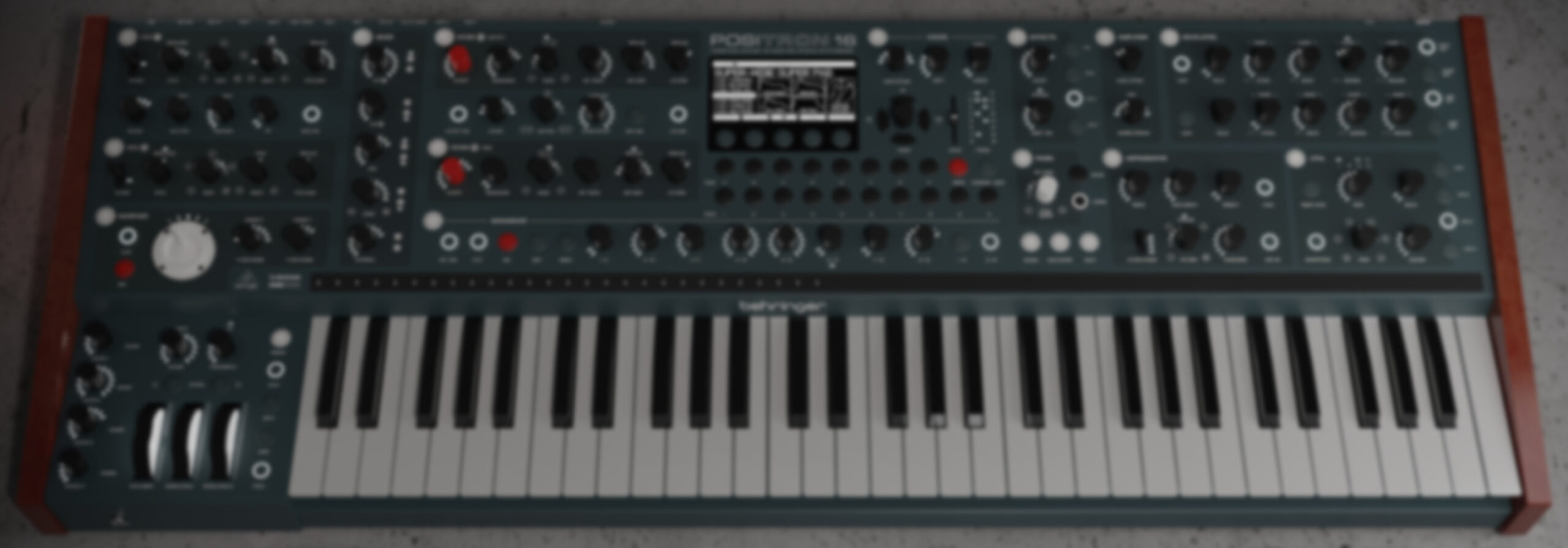We’ve all seen those arguments online: whether a certain vintage synth has the oscillator circuit or filter chip, and how important it is for the overall sound of the instrument. Actually, most of us have probably started such a topic once or twice.
This is not one of those topics. On the contrary, in this post I will try to convince you that the filter and oscillators of your favourite synth doesn’t really matter all that much. Or at least not as much as you might think.
The power of first impression
Think of a synth you like. What comes to mind? I would hazard a guess and say it’s an image of its front panel and controls. Its interface, that lets you control it and conjure all kinds of cool sounds out of it. Similarly, when a new instrument is announced by a manufacturer, it usually starts with photos of the synth and your lust after it is born from just looking at it. ‘See all those buttons and knobs! Oh, it’s just covered in sliders! Wow, look at those controls!” We see the interface and imagine what we could do with it.

That’s not to say the sound isn’t important. Or vital, even. No interface in the world would save a poorly performing synthesiser, that’s for sure. But reversely, no oscillators or filters will save a synth without a good interface, that lets you tweak the sounds to your liking. Unless of course we’re talking about preset machines, but that’s a topic for another day.
Control is everything
Let’s say we have a synthesiser, with oscillators, filters, envelopes and LFOs. The sound is great, with rich waveforms, creamy filters, snappy envelopes and a bunch of modulation paths. But the frontpanel has just a numeric display and a few buttons. Not even a data entry encoder.
What do you do? You step through the presets and play a few phrases. Wow, it sounds really great! This string patch for instance is really something. If only it was a bit brighter – let’s turn up the filt… Oh. Yeah, that’s right: we can’t. Well, perhaps there’s another string patch with a brighter sound. I’ll just step through some more of the… erm, 1000 patches… Damn.

Yes, I’m talking about the Oberheim Matrix-1000. It’s a real paradox, with its rich Oberheim sound and Xpander-like mod matrix, but without any sound editing controls what so ever.
Ok, so the Matrix-1000 example might be a bit extreme. Apart from the aforementioned preset boxes, most synthesisers have some form of real-time controls. But even then it really matters which ones they are – and, somewhat contradictory, it might even matter more which ones they are not.
Now you see it – now you don’t
Some of the most popular and beloved instruments have had quite a limited sets of controls. The Roland Juno series comes to mind: a 6-voice analogue poly-synth with a single oscillator (and sub), a simple lowpass filter and a single envelope and LFO should end up being quite limiting, but instead the simplicity allowed you to focus on the core elements of the sounds.

Or take the good old Oberheim SEM: a dual oscillator mono synth with a multi-mode filter, 2 simple ADS envelopes and an even simpler LFO and you should have an extremely boring instrument, but instead you have an absolute classic, capable of anything from screaming leads, booming basses and anything in between.

Sure, these instruments won’t ever do complex modulations or sound effects like a Matrix-12, but that’s not the point. The controls you don’t have also don’t get in the way of you creating your own sounds.
Speaking of the mighty Oberheim Matrix-12 and its older sibling, the Xpander: they are true beasts when it comes to sound generation, with a bunch of envelopes, LFOs and ramp generators and an exhaustive modulation matrix. But all these options came at a cost, and the interface had to be abstracted to enable Oberheim to create a frontpanel that wouldn’t end up being prohibitively expensive to manufacture or require overly complex circuit boards. (Which is not to say that the instruments in question were in any way affordable, or simple to maintain and service).

So we ended up with a bunch of buttons (‘Pages’) that enables a set of controls shown as text in the twin vacuum fluorescent displays, with values edited by more buttons and the 6 rotary encoders. Powerful, yes. Intuitive – maybe… Quick? No.
Intuitive controls vs powerful synthesis
So what’s the point I’m making? Simpler is better? Well, yes and no. A few key controls are always better than a complex and cumbersome interface, that’s for sure. But we also want powerful modulations and real-time tweaking of all the key sound generating components.
The point is that the controls we’ve got influence the sounds you create with the synth more than whatever filter chips are used, or if the oscillators are VCOs or DCOs. If you search the web, you will find videos showing how to make one particular synth sound like that other particular synth, or how to coax analogue sounds out of digital synths. If you close your eyes, even a Casio CZ-101 or a Yamaha DX-7 can sound like a lush Prophet 5 or a rich OB-8.
But when you open your eyes again, and see a confusing forest of buttons and a single input slider (or, in the case of the CZ-series, not even that…), your enthusiasm dampens somewhat. Sure, they can sound great but the interfaces are slow and cumbersome, so you just end up playing the presets.
The holy grail
What we really want is a synth with immense synthesis power but a quick and easy-to-use interface. And there have been those who have tried. Some could even be considered to have succeeded – at least to a degree.
The Arturia Matrixbrute is one. Basically every function of this big and heavy analogue mono synth has its own real-time control, with the big (some would say excessive) frontpanel adorned with countless knobs, buttons and sliders. Oh, and that massive illuminated modulation matrix in main focus, of course.

The Alesis Andromeda A6 is another, with its 16 analogue voices controlled by a multitude of buttons and knobs, making it easy to create all kinds of marvelous sounds.

And then there is the Waldorf Wave. This hybrid analogue/digital instrument, with wavetable oscillators inherited from the legendary PPG namesake, has almost all its complex sound components accessible by real-time controls.

I didn’t pick these three synthesisers at random. Not only are they very hands-on and quick to work with despite their complexity, but they are all designed by the same person – the market leader in synthesiser design, Axel Hartmann.
So why are they so good? The secret is Hartmann’s clear and easy-to-read panel layouts and the careful and well-considered choice of what controls to include. And it’s not just about making every single sound parameters available as a knob, button or slider. It’s also important to decide what to leave out, and what to put in focus.
Look at the big red wheel on the Wave – it draws your eyes to it, inviting you to turn it to see what happens (it scrolls through the wavetable, letting you hear all the available waves). Or cast an eye at the Andromeda’s panel. Those organic shapes are not just for show – they group related controls together in a very intuitive way, making sure you know what knobs and buttons work together. And the Matrixbrute’s big mod matrix gives you instant access to all its modulation paths at the push of one of its buttons (or control of its 64 step sequencer, or selection of one of its 256 patches).
The future
I mentioned that the 3 synths above had succeeded to a degree, and by that I meant that there are still limitations to their interfaces. Perhaps the biggest – and one that they share with most other hardware synths with patch storage – is that the physical controls on the frontpanel does not necessarily reflect the sound you’re listening to. Once you load a new patch, all the positions of the knobs and sliders will show the last tweaks you made, which might be on the previous patch or even one before that, and the new values could be completely different.
This is the classic ‘catch’ or ‘jump’ dilemma, where you’re (sometimes) given a choice as to whether the controls should immediately change the parameters to the control’s physical position once you tweak it (jump) or if you would need to tweak it to the stored value before the control becomes active (catch). Both ways work, but not perfectly, and some people prefer one method over the other but neither of them are optimal for live performances of quick tweaks of your sound on the fly.
Enter the LED encoders. I’ve been a long-time proponent of these controls, but they have historically been too expensive or have had too low a resolution to be viable for a complete frontpanel layout.

Not any more: the latest breed of MIDI controllers boast large numbers of LED encoders with a good amount of resolution, and to a very fair price. So I say that it’s time to let go of the past and embrace the immediacy of LED encoders as the main controls for our synthesisers.
Which is why when Behringer asked if anyone had any ideas for new analogue poly-synths, I made sure to use LED encoders as the main input control type for my concept, the Positron 16.

This way, the frontpanel always shows you the current state of the synth, no matter if you’ve just loaded a new patch or been tweaking for hours. I’ve also picked a few ideas from Hartmann’s designs and added highlighted controls for the most important aspects of the sound, like filter cutoffs and morphing.
Conclusion
And there you have it: this is why I propose that the frontpanel design and input controls of a synth are just as important as the sound generating components. The available controls guide your mind, leading you to specific sounds.
Do you agree or disagree? Please let me know in the comments.








